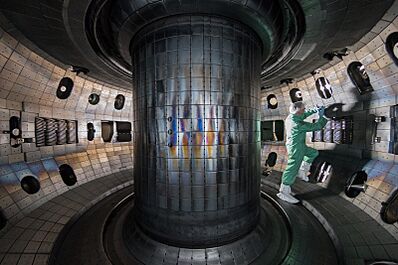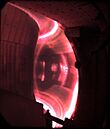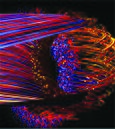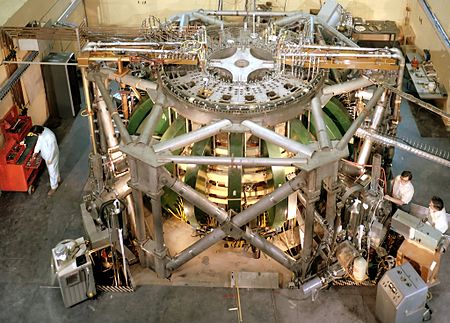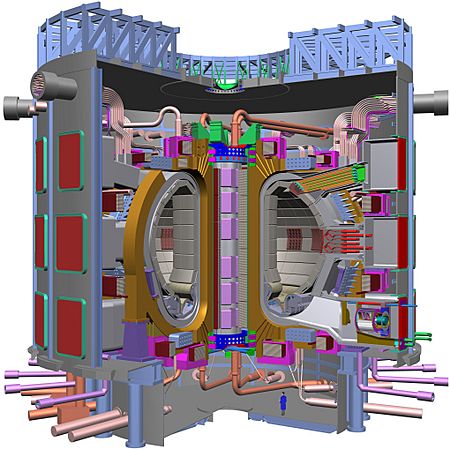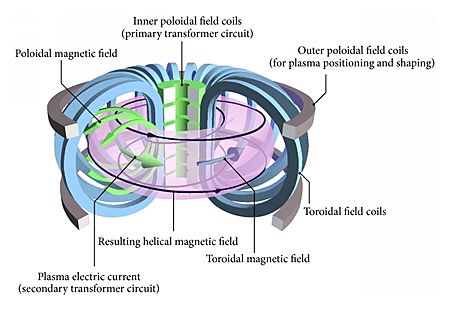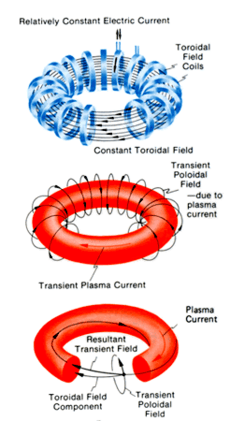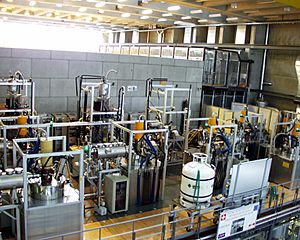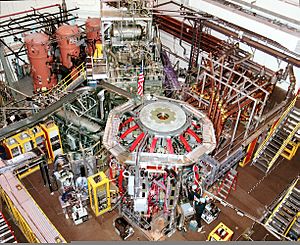Tokamak facts for kids
- Inside the EAST tokamak in China, showing its shape and magnets.
- The DIII-D tokamak chamber in the US.
- Hot plasma glowing inside the EAST tokamak.
- A computer picture of swirling particles in a tokamak.
- The JET experiment in the UK, which set fusion records.
- The JT-60SA in Japan, the biggest tokamak working today.
A tokamak (say "TOE-ka-mack") is a special machine that uses strong magnets to hold super-hot gas, called plasma, in a donut shape. Scientists are building tokamaks to create fusion power, which is the same energy process that powers the Sun. This energy could provide clean electricity for our homes.
The idea for using controlled fusion for power was first suggested by Soviet physicist Oleg Lavrentiev in the 1950s. In 1951, Andrei Sakharov and Igor Tamm improved this idea. They suggested using a magnetic field to hold the plasma in a donut shape.
The first tokamak was built in the Soviet Union in 1954. In 1968, a tokamak called T-3, built at the Kurchatov Institute, reached very high plasma temperatures. When these amazing results were shared, other scientists were doubtful. So, Soviet scientists invited British scientists to check their findings. The British team confirmed the results, which led to many countries building their own tokamaks.
Scientists learned that to keep the plasma stable, the magnetic field lines inside the tokamak needed to twist like a spiral. This twisting helps prevent the plasma from escaping. A key idea called the "safety factor" (known as q) helped guide tokamak design. By keeping q greater than 1, tokamaks could stop the plasma from becoming unstable.
By the mid-1960s, tokamaks started showing much better results. The Princeton Large Torus (PLT) in the US began operating in 1975. It was one of the first big tokamaks and set a record for plasma temperature, reaching 75 million degrees Kelvin. This temperature is hot enough for fusion to happen.
By the late 1970s, many tokamaks were running worldwide. These machines had achieved all the conditions needed for practical fusion, though not all at once. Scientists then designed new machines to run on a special fusion fuel made of deuterium and tritium.
The Tokamak Fusion Test Reactor (TFTR) in the US and the Joint European Torus (JET) in Europe did many experiments. They studied and improved how plasma behaved, leading to high energy confinement and fusion rates. TFTR found new ways to run plasma, called "supershots." JET improved a method called the High-confinement mode (H-mode).
Both TFTR and JET used deuterium and tritium fuel. As of 2025, they were the only tokamaks to do so. TFTR created 1.6 gigajoules of fusion energy. JET set a record with 16 megawatts of fusion power. JET also produced 69 megajoules of energy over 5 seconds.
These experiments showed new problems that limited performance. Solving them would need a much bigger and more expensive machine. In 1985, Ronald Reagan and Mikhail Gorbachev agreed to work together. This led to the International Thermonuclear Experimental Reactor (ITER) project. ITER is the main international effort to develop practical fusion power. Many smaller tokamaks are still used to study different aspects of fusion.
Contents
- What Does "Tokamak" Mean?
- How Tokamaks Were Developed
- Early Fusion Ideas
- Lavrentiev's Idea
- Using Magnets to Hold Plasma
- Richter and the Start of Fusion Research
- New Ideas and Instability
- Moving Towards Open Research
- The First Tokamaks
- The "Doldrums" and New Progress
- Heating: US Takes the Lead
- 1980s: High Hopes and Challenges
- ITER: A Global Effort
- High Field Tokamaks
- How a Tokamak Works
- Heating the Plasma
- What Happens to Particles?
- Tokamak Experiments Around the World
- See also
What Does "Tokamak" Mean?
The word tokamak comes from a Russian word. It is a short way of saying:
- toroidal chamber with magnetic coils
- Or, toroidal chamber with axial magnetic field
The term "tokamak" was created in 1957 by Igor Golovin. It was first "tokamag," but another scientist, Natan Yavlinsky, suggested changing it to "tokamak" because it sounded better. Many languages later borrowed this name.
How Tokamaks Were Developed
Early Fusion Ideas
In 1934, scientists first made fusion happen on Earth using a particle accelerator. They shot deuterium atoms into metal. This helped them learn how different fusion reactions work.
Making fusion happen with accelerators is not practical. Most particles just bounce off the fuel instead of fusing. To get useful energy, the fuel needs to be super hot. This is why it's called thermonuclear fusion. In 1944, Enrico Fermi figured out that fusion could keep itself going at about 50 million degrees Kelvin.
During the Manhattan Project, scientists found a way to reach these high temperatures using an atomic bomb. Some scientists also thought about how to make a controlled fusion device.
The first attempts to build a practical fusion machine were in the United Kingdom in 1945. They used a method called the pinch effect. Early experiments didn't show clear signs of fusion.
Lavrentiev's Idea
In 1950, Oleg Lavrentiev, a Soviet soldier, wrote a letter. He suggested using an atomic bomb to start fusion fuel. He also described a system that used electric fields to hold hot plasma for energy production.
His letter was sent to Andrei Sakharov for review. Sakharov thought it was a very important idea. He worried that the plasma might hit the electrodes.
Lavrentiev's letter was taken very seriously. Sakharov and Igor Tamm quickly wrote a detailed plan for a fusion reactor. They asked for money to build it in January 1951.
Using Magnets to Hold Plasma
When plasma gets hot enough for fusion, its electrons separate from the atoms. This creates a fluid of nuclei and electrons. Plasma conducts electricity, so magnets can control it.
Sakharov worried about using electrodes. He thought about using magnetic fields instead. In a magnetic field, charged particles spiral around the field lines. If the field lines are close and parallel, particles can collide and fuse.
A simple magnetic field can be made with a solenoid, a cylinder with magnets around it. This stops particles from moving sideways. But particles can still escape from the ends. Bending the cylinder into a donut shape, called a torus, solves this. The field lines form continuous rings, and particles circle endlessly.
However, Sakharov and Tamm realized a problem. When magnets are bent into a torus, they are closer on the inside edge. This creates uneven forces that make particles drift away.
Sakharov suggested two ways to fix this. One was to put a current-carrying ring in the middle of the torus. This current would twist the magnetic field into a helix. Particles would then move from the inside to the outside of the torus. The drifts would cancel out over time. Another idea was to make the plasma itself carry a current.
In January 1951, a meeting was held to discuss Sakharov's ideas. Everyone was interested, and a report was sent to Lavrentiy Beria, who was in charge of atomic efforts.
Richter and the Start of Fusion Research

On March 25, 1951, Argentina's President Juan Perón announced that a scientist named Ronald Richter had made fusion happen. Scientists worldwide were excited but soon realized it wasn't true. Richter's setup couldn't heat the fuel enough.
Even though Richter's claim was false, it made politicians aware of fusion research. In the UK, scientists suddenly got a lot of money for fusion. In the US, Lyman Spitzer designed his stellarator concept.
Similar things happened in the Soviet Union. Igor Kurchatov quickly proposed setting up a fusion research lab. Just days later, on May 5, Joseph Stalin approved the plan.
New Ideas and Instability
By October 1950, Sakharov and Tamm had a more detailed plan. They imagined a device 12 meters wide and 2 meters tall.
Scientists later realized that a strong current in the plasma could also hold it in place. This was similar to the pinch system in the UK. But the Soviet scientists came to this idea from a different starting point.
A simpler idea emerged: inducing current in a straight tube. This would make the plasma collapse into a thin line. The current would heat the plasma, and the collapse would make it even hotter. Only Golovin and Natan Yavlinsky continued to work on the toroidal (donut-shaped) design.
On July 4, 1952, scientists saw neutrons from a linear pinch machine. At first, they thought it was fusion. But they found the neutrons came from instabilities in the plasma. This problem also happened in the UK and US.
Scientists studied these instabilities. They found two main types: "sausage" in linear machines and "kink" in toroidal machines. They looked for ways to stop them. One idea was the "stabilized pinch." This added coils to create a magnetic field that would help stabilize the plasma.
Sakharov re-thought his toroidal ideas. He concluded that the external magnetic field should be much stronger to hold the plasma. The internal current would be smaller and mainly for stability.
Moving Towards Open Research
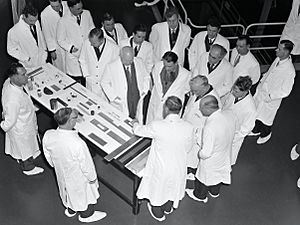
In 1955, with linear fusion machines still having problems, the first toroidal device was built in the USSR. It showed that the plasma was hitting the chamber walls. Two smaller machines were built to try to fix this.
In 1955, Kurchatov decided to open up fusion research in the USSR. In April 1956, Kurchatov visited the UK. He surprised everyone by sharing details of Soviet fusion efforts. He warned that seeing neutrons didn't always mean fusion.
Unknown to Kurchatov, the British were building a huge stabilized pinch machine called ZETA. In January 1958, they announced ZETA had achieved fusion.
Soviet scientists Vitaly Shafranov and Stanislav Braginskii studied the news. They thought ZETA was similar to their own designs.
The First Tokamaks
Soviet scientists decided to build a larger toroidal machine based on Sakharov's ideas. They focused on a key point: if particles twisted around the plasma's circumference faster than they circled the torus's long axis, the "kink" instability would be stopped.
This idea is now called the safety factor, or q. If q is greater than 1, the kink instability is suppressed. This means the external magnets must be much stronger, or the internal current must be smaller.
Design began on T-1, which is now known as the first real tokamak. T-1 used stronger external magnetic fields and less current than pinch machines like ZETA. T-1's success made it the first working tokamak.
In May 1958, the ZETA team announced they had not achieved fusion. Their temperature measurements were wrong.
T-1 started working in late 1958. It lost a lot of energy due to impurities from the vacuum chamber. T-2 was built to solve this. It used a special metal lining that was baked to remove trapped gases.
The "Doldrums" and New Progress
At a meeting in Geneva in 1958, the Soviets shared their fusion research. Spitzer's stellarator design caught their eye. Stellarators twist the plasma without needing a current, so they can run continuously. Kurchatov wanted to change their T-3 design to a stellarator. But his team convinced him that the current in their design also helped heat the plasma.
By the early 1960s, all fusion designs were losing plasma too quickly. This led to a period of great pessimism called "the doldrums."
However, tokamaks seemed to be doing well. By the mid-1960s, they showed signs of beating the "Bohm limit," which suggested magnetic confinement wouldn't work.
At a conference in 1965, Artsimovich reported that their tokamaks were 10 times better than the Bohm limit. Spitzer was still doubtful.
At a meeting in August 1968, the Soviets announced that their T-3 tokamak was reaching electron temperatures of 10 million degrees Celsius. This was 10 times better than any other machine. Many thought these results were due to "runaway electrons," not the main plasma.
The Culham Five
After the ZETA issues, British scientists developed new ways to measure plasma. One was using a laser to measure electron temperature directly. Artsimovich invited British physicists to the Kurchatov Institute to test their devices. This was a big deal during the Cold War.
The British team, called "The Culham Five," arrived in late 1968. By August 1969, their measurements confirmed the Soviet results. This news led to a "stampede" of tokamak building worldwide.
One problem remained: the plasma temperature was limited by how much the current could heat it. As plasma got hotter, its resistance dropped, making heating less effective. Scientists knew new heating methods were needed.
US Tokamak Race
In the US, scientists at Oak Ridge designed a new tokamak called Ormak. It used a single large copper block for the external magnetic field, which made the field more even. This also allowed for a smaller "aspect ratio," which the Soviets thought would give better results.
In early 1969, Artsimovich visited MIT. MIT became interested in tokamaks. Bruno Coppi at MIT designed his own low-aspect-ratio tokamak, Alcator.
Other groups also joined the race. General Atomics proposed Doublet, a tokamak with a non-circular plasma shape. The University of Texas at Austin proposed the Texas Turbulent Tokamak to explore heating plasma with turbulence.
By June 1969, many tokamak proposals were being considered in the US. Princeton, which had a stellarator, was hesitant to switch. But after much debate, Princeton decided to convert its stellarator into a "stellarator-tokamak" to verify the Soviet results.
In October, funding was approved for all these projects. Princeton's new machine, the Symmetrical Tokamak, aimed to confirm the Soviet findings. Others would try to go beyond T-3.
Heating: US Takes the Lead
Experiments on the Symmetric Tokamak began in May 1970. By early 1971, they confirmed and then surpassed the Soviet results. Princeton then focused on heating the plasma. They explored two ideas: magnetic compression and neutral beam injection.
The Adiabatic Toroidal Compressor (ATC) at Princeton started in May 1972. It was followed by an Ormak with neutral beams. Princeton added beam injectors to ATC and showed successful heating in 1973.
A much larger machine, the Princeton Large Torus (PLT), was being built. PLT was designed to show if tokamaks with extra heating could lead to a future fusion reactor. PLT was a huge success. It kept raising its internal temperature until it reached 60 million degrees Celsius in 1978. This was a major step, as fusion reactions become self-sustaining between 50 and 100 million degrees Celsius.
These experiments, especially PLT, put the US ahead in tokamak research. This was partly because the US had a larger budget for fusion research.
During this time, Robert L. Hirsch took over the US fusion program. He wanted to show real results to keep funding. The program shifted from scientific exploration to building a working power reactor. The 1973 oil crisis also increased interest in new energy sources.
1980s: High Hopes and Challenges
By the late 1970s, tokamaks had achieved all the conditions needed for a practical fusion reactor. PLT showed ignition temperatures. The Soviet T-7 used superconducting magnets for the first time. Doublet showed that "shaped plasma" worked well. It seemed all that was needed was to combine these ideas into one machine that could use radioactive tritium fuel.
In the 1970s, four major second-generation tokamaks were funded. The Soviets continued with T-15. Europe started the Joint European Torus (JET). Japan began the JT-60 project. In the US, Hirsch planned the Tokamak Fusion Test Reactor (TFTR).
TFTR started operating in 1982, followed by JET in 1983 and JT-60 in 1985. JET quickly led in experiments. But soon, new problems appeared. New instabilities showed up, and practical issues interfered with performance. Plasma sometimes hit the reactor walls in TFTR and JET. Even when working perfectly, plasma confinement was still too low for a practical reactor.
By the mid-1980s, scientists understood many of these problems. Solutions were found, but they would make machines much larger and more expensive. This led to a new period of pessimism in fusion research.
ITER: A Global Effort
At the same time, funding for fusion in the US decreased. In 1986, Ronald Reagan said the energy crisis was over.
An idea for an international reactor, INTOR, had been discussed since 1973. It was started by an agreement between Richard Nixon and Leonid Brezhnev.
At the Geneva Summit in November 1985, Reagan and Mikhail Gorbachev agreed to restart this cooperation. They emphasized the importance of fusion for peaceful purposes.
The next year, the US, Soviet Union, European Union, and Japan signed an agreement. This created the International Thermonuclear Experimental Reactor (ITER) organization.
Design work for ITER began in 1988. Since then, ITER has been the main tokamak design effort worldwide. Construction began in 2010. First plasma is expected in 2025, and full operation by 2035.
High Field Tokamaks
Scientists have long known that stronger magnets could make smaller tokamaks achieve high energy gain.
New high temperature superconductors (HTS) became available in the 2010s. These allow for much stronger magnets. In 2021, the MIT Plasma Science and Fusion Center and Commonwealth Fusion Systems successfully tested a magnet that created a 20 Tesla magnetic field. This is needed for SPARC, a device designed to achieve similar energy gain as ITER but in a much smaller size.
British company Tokamak Energy is also planning a net-energy tokamak using HTS magnets. Their design uses a "spherical tokamak" shape.
The joint EU/Japan JT-60SA reactor achieved its "first plasma" on October 23, 2023.
How a Tokamak Works
The Basic Challenge
Fusion plasma contains super-hot, fast-moving charged particles (ions and electrons). To keep fusion going, these particles must stay in the central region. Otherwise, the plasma cools down quickly. Magnetic confinement devices use the fact that charged particles spiral along magnetic field lines.
The simplest magnetic system is a straight tube with magnets (a solenoid). This stops particles from moving sideways. But particles can still escape from the ends. Bending the tube into a donut (a torus) seems to solve this. However, the magnetic field is stronger on the inside edge of the donut. This causes particles to drift and hit the walls.
The solution is to twist the magnetic field lines. They don't just go around the torus; they spiral like a barber pole. This way, a particle drifts one way on the outside edge and the other way on the inside edge. These drifts mostly cancel out, keeping the fuel inside longer.
The Tokamak Solution
Early solutions to create this twist were the stellarator (which twisted the whole machine) and the z-pinch (which ran an electric current through the plasma). Both improved confinement but still lost plasma too quickly.
The tokamak is similar to the z-pinch. Its key idea was realizing that the instabilities causing plasma loss could be controlled. The important factor was how "twisty" the fields were. Fields that made particles twist more than once per orbit around the torus were much more stable. This "twistiness" ratio is called the safety factor, or q. Older devices operated at q around 1/3, while tokamaks operate at q much greater than 1. This makes them much more stable.
A vertical magnetic field is also needed. The force from the plasma current in this vertical field helps hold the plasma donut in place.
Other Important Issues
Early tokamaks had a limit on how hot their ions could get.
While tokamaks are generally stable, plasmas can still have small, fast instabilities. The "kink instability" is largely stopped by the tokamak's high safety factor. This allowed tokamaks to reach higher temperatures, which then revealed new effects.
One effect is "banana orbits." In a tokamak, particles with different energies move differently. Low-energy particles can reflect off stronger magnetic fields and travel backward, colliding with other particles and scattering them out. This causes some fuel loss, but it's slow enough for a practical reactor.
Another issue is "tearing instability." In 2024, scientists used reinforcement learning to predict and reduce these instabilities in the DIII-D tokamak. This helped keep the plasma stable while maintaining high performance.
Breakeven, Q, and Ignition
A main goal for fusion devices is to reach breakeven. This is when the energy produced by fusion equals the energy used to keep the reaction going. The ratio of output to input energy is called Q. Breakeven means Q is 1. For a reactor to produce net energy, Q needs to be much higher.
Once breakeven is reached, Q usually increases quickly. This is because some of the energy from fusion reactions (especially from deuterium and tritium fuel) comes from alpha particles. These alpha particles can heat the plasma, reducing the need for outside heating. At a point called ignition, this self-heating is enough to keep the reaction going without any external heat. This would mean an infinite Q.
For a tokamak, self-heating works best if the alpha particles stay in the fuel long enough to collide. Since alphas are charged, the magnetic fields hold them. This happens when the electric current in the plasma is about 3 megaamperes.
Advanced Tokamaks
In the early 1970s, scientists at Princeton studied future tokamak designs. They noticed that the main magnets would have more tension on the inside curve. They found that shaping the magnets like a "D" instead of an "O" would even out these forces. This became known as the "Princeton D-coil."
This D-shape also helped with plasma stability. The "safety factor" varies across the plasma. A D-shape could help keep the average q higher.
The JET was one of the first machines to use a D-shaped plasma. This shape also helped reduce the net force pushing the reactor inward. The D-shape has become common in almost all modern tokamaks.
One problem in all fusion reactors is that heavier elements cool the plasma. A solution is the divertor. This is like a large mass spectrometer that flings heavier elements out of the reactor. Designing a divertor for a tokamak was difficult.
Another problem is the heat on the reactor walls. Hot plasma can damage the walls. Most tokamaks use a limiter, a ring of light metal that the plasma hits first. This protects the main walls.
With D-shaped plasmas, scientists found they could shape the escaping particles. This led to internal divertors that send heavier elements to the bottom of the reactor. There, a pool of liquid lithium metal acts as a limiter. It's easier to cool and causes less disruption if its atoms mix with the fuel.
As machines explored these shaped plasmas, they found certain conditions led to the high-confinement mode, or H-mode. In H-mode, the plasma operates stably at higher temperatures and pressures. H-mode is now a major goal for tokamak design.
Finally, scientists noticed that uneven plasma density creates internal electric currents, called the bootstrap current. This means a well-designed reactor can generate some of the current needed to twist the magnetic field lines itself. Modern designs try to use as much bootstrap current as possible.
By the early 1990s, these features led to the "advanced tokamak" concept. This is the basis for modern research, including ITER.
Plasma Disruptions
Tokamaks can have "disruptions," where the plasma confinement is lost in milliseconds. There are two main types. A "vertical displacement event" (VDE) is when the plasma moves vertically and touches the chamber wall. A "major disruption" is when instabilities make the plasma lose its symmetrical shape.
When the plasma touches the walls, it cools very quickly. In a major disruption, the plasma current briefly increases before dropping. In a VDE, the current drops at the same time as cooling. In both cases, the plasma's heat and electrical load hit the reactor vessel very fast. ITER is designed to handle many of these events.
In modern high-energy devices like ITER, with huge plasma currents, a major disruption can cause "runaway electrons." These electrons are accelerated to very high speeds and keep their energy even as the main current drops.
When confinement breaks, these runaway electrons hit the reactor walls. They can carry huge currents in a small area, which can cause damage. In one case, a tokamak called Tokamak de Fontenay aux Roses had a major disruption where runaway electrons burned a hole through the vacuum chamber.
Major disruptions happen often in tokamaks. In ITER, even a few major disruptions could damage the chamber permanently. So, developing systems to stop runaway electrons is crucial for ITER.
Sometimes, smaller "internal disruptions" or "sawteeth" happen. These don't usually stop the plasma discharge.
If the plasma density goes over a certain limit (the Greenwald limit), it can also lead to disruptions.
Heating the Plasma
In a working fusion reactor, some of the energy produced will keep the plasma hot as new fuel is added. But to start a reactor, the plasma must be heated to over 100 million degrees Celsius. In current fusion experiments, not enough fusion energy is produced to keep the plasma hot, so constant external heating is needed. Chinese researchers set up the Experimental Advanced Superconducting Tokamak (EAST) in 2006. It can reportedly keep plasma at 100 million degrees Celsius for fusion.
Ohmic Heating
Plasma conducts electricity. So, scientists can heat it by sending a current through it. This induced current also creates most of the magnetic field that twists the plasma.
This heating is called ohmic (or resistive) heating. It's like how an electric heater works. The heat depends on the plasma's resistance and the current. But as plasma gets hotter, its resistance drops. This makes ohmic heating less effective. The highest temperature ohmic heating can reach in a tokamak is about 20–30 million degrees Celsius. To get hotter, other heating methods are needed.
The current is created by increasing the current in a coil around the plasma. The plasma acts like the secondary coil of a transformer. This process has to be pulsed, meaning it can only run for short periods. So, tokamaks need other ways to heat the plasma for longer operations.
Magnetic Compression
A gas gets hotter when it's suddenly squeezed. Similarly, plasma temperature increases if it's quickly compressed by making the magnetic field stronger. In a tokamak, this is done by moving the plasma inward to a region with a stronger magnetic field. This also brings ions closer, helping to reach the needed density for fusion.
Magnetic compression was studied early in tokamak development. It's not widely used now, but similar ideas are part of some new designs.
Neutral-Beam Injection
Neutral-beam injection involves shooting high-energy atoms into the plasma.
These high-energy atoms start as ions in a special chamber. They are then sped up by high voltage. These ions are then combined with electrons to become neutral atoms. Neutral atoms can travel through the magnetic fields into the tokamak.
Once inside, these neutral atoms hit the plasma ions. This does two things. First, the injected atoms become charged again and get trapped in the reactor, adding to the fuel. Second, these collisions transfer energy to the plasma, heating it up.
This heating method has no temperature limit, unlike ohmic heating. Its rate is limited by the power of the injectors.
Neutral beam injection is mainly for heating. But it can also be used to study the plasma or control it. Deuterium is a main fuel for these systems.
Radio-Frequency Heating
High-frequency electromagnetic waves are made by devices outside the tokamak. If these waves have the right frequency and direction, their energy can be given to the charged particles in the plasma. These particles then collide with others, raising the plasma's temperature. This energy is usually transferred by microwaves.
What Happens to Particles?
Plasma inside the tokamak's vacuum chamber consists of energized ions and atoms. These particles eventually reach the inner wall of the chamber through radiation, collisions, or by escaping the magnetic field. The heat from these particles is removed by a water-cooling system in the chamber walls.
Special pumps remove particles from the main plasma. Cryogenic pumps, which use a liquid helium-cooled surface, help control the plasma density by condensing particles. When fusion reactions happen correctly, they produce a lot of high-energy neutrons. Neutrons are not affected by magnetic fields and pass through the vacuum chamber easily.
The neutron flow is greatly reduced by a special neutron shield around the tokamak. Shield materials are usually made of atoms similar in size to neutrons, as these are best at absorbing neutrons and their energy. Water and plastics, which have a lot of hydrogen, are good choices. Boron atoms also absorb neutrons well. So, concrete and polyethylene mixed with boron are cheap neutron shielding materials.
Once free, neutrons decay in about 10 minutes. In a future power plant, some neutrons from fusion would be absorbed by a liquid metal blanket. Their energy would be used to heat water, create steam, and turn a generator to make electricity.
Tokamak Experiments Around the World
Currently Running Tokamaks
- 1960s: Golem in Prague, Czech Republic (originally TM1-MH in Russia)
- 1975: T-10 in Moscow, Russia
- 1986: DIII-D in San Diego, United States
- 1987: STOR-M in Saskatchewan, Canada
- 1988: WEST (formerly Tore Supra) in Cadarache, France
- 1989: Aditya in Gujarat, India
- 1989: COMPASS in Prague, Czech Republic (moved from UK in 2008)
- 1990: FTU in Frascati, Italy
- 1991: ISTTOK in Lisbon, Portugal
- 1991: ASDEX Upgrade in Garching, Germany
- 1992: H-1NF in Australia
- 1992: Tokamak à configuration variable (TCV) in Switzerland
- 1993: HBT-EP Tokamak in New York City, US
- 1994: TCABR in São Paulo, Brazil
- 1996: Pegasus Toroidal Experiment in Madison, Wisconsin, US
- 1999: NSTX in Princeton, New Jersey, US
- 1999: Globus-M in Saint Petersburg, Russia
- 2000: ETE in São Paulo, Brazil
- 2002: HL-2A in Chengdu, China
- 2006: EAST in Hefei, China
- 2007: QUEST in Fukuoka, Japan
- 2008: KSTAR in Daejon, South Korea
- 2012: Medusa CR in Cartago, Costa Rica
- 2012: SST-1 in Gandhinagar, India
- 2012: IR-T1 in Tehran, Iran
- 2015: ST25-HTS in Culham, United Kingdom
- 2017: KTM in Kazakhstan
- 2018: ST40 in Oxford, United Kingdom
- 2020: HL-2M in China
- 2020: MAST Upgrade in Culham, United Kingdom
- 2023: JT-60SA in Naka, Japan (an upgrade of JT-60)
- 2024: HH70 in China
Previously Operated Tokamaks
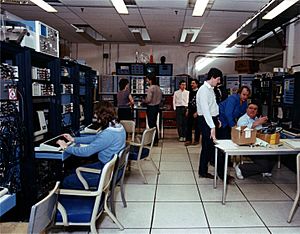
- 1960s: T-3 and T-4 in Moscow, Russia
- 1963: LT-1 in Australia
- 1970: Symmetric Tokamak at PPPL, US
- 1971–1980: Texas Turbulent Tokamak in Texas, US
- 1972: Adiabatic Toroidal Compressor at PPPL, US
- 1973–1976: Tokamak de Fontenay aux Roses (TFR) near Paris, France
- 1973–1979: Alcator A at MIT, US
- 1975: Princeton Large Torus at PPPL, US
- 1978–1987: Alcator C at MIT, US
- 1978–2013: TEXTOR in Jülich, Germany
- 1979–1998: MT-1 Tokamak in Budapest, Hungary
- 1980–1990: Tokoloshe Tokamak in South Africa
- 1980–2004: TEXT/TEXT-U in Texas, US
- 1982–1997: TFTR at Princeton University, US
- 1983–2023: Joint European Torus (JET) in Culham, United Kingdom
- 1983–2000: Novillo Tokamak in Mexico City, Mexico
- 1984–1992: HL-1 Tokamak in Chengdu, China
- 1985–2010: JT-60 in Naka, Japan
- 1987–1999: Tokamak de Varennes in Varennes, Canada
- 1988–2005: T-15 in Moscow, Russia
- 1991–1998: START in Culham, United Kingdom
- 1990s–2001: COMPASS in Culham, United Kingdom
- 1994–2001: HL-1M Tokamak in Chengdu, China
- 1999–2006: UCLA Electric Tokamak in Los Angeles, US
- 1999–2014: MAST in Culham, United Kingdom
- 1992–2016: Alcator C-Mod at MIT, US
- 1995–2013: HT-7 in Hefei, China
Planned Tokamaks
- ITER, an international project in Cadarache, France. It aims to produce 500 MW of power. Construction began in 2010, with first plasma expected in 2025. It should be fully working by 2035.
- DEMO, a planned successor to ITER. It aims for continuous operation and to connect to the power grid. Construction is planned to begin in 2040.
- CFETR, or "China Fusion Engineering Test Reactor." This is China's next-generation tokamak.
- K-DEMO in South Korea. It plans to generate about 500 MW of electricity. Construction is aimed for 2037.
- Spherical Tokamak for Energy Production (STEP), a UK project. It plans to produce a burning plasma by 2035.
- SPARC by Commonwealth Fusion Systems (CFS) and MIT. It aims to achieve energy gain in 2026. It will be much smaller than ITER by using very strong magnetic fields.
See also
 In Spanish: Tokamak para niños
In Spanish: Tokamak para niños
- Edge-localized mode, a type of tokamak plasma instability
- Reversed-field pinch, another type of fusion device
- Lawson criterion, a condition needed for fusion to produce net energy


